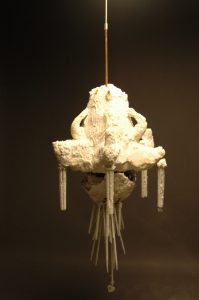
By Andi Tomassi and Deon Blackwell
Salt: A Study of Decay and Stasis
TROn: Would you please talk a little bit about the conception of the chandelier pieces, and also about the process that you go through to make them?
Deon Blackwell: The chandeliers came during my first years of grad school. At that time, I lost several members of my family to cancer and suicide within a few months of each other. I was fascinated by the process of cancer and chemotherapy and what they do to the body. My aunt had lung cancer and I watched her hair fall out and skin change colors, but her hair came back softer and more fine than before.
Their bodies were eroding and changing and people that I had known all of my life were changed dramatically in front of my eyes. I experimented with many mediums to try to find something that could be used to replicate that experience in my art work. I came across salt as a material. Salt was very destructive to my tools, to [my work] environment, and especially to me. It was difficult to work with and painful most of the time. I was also working with ceramics in my practices and found a common ground. Each chandelier is based on body parts or the process of a person breaking down. But in that destructive process is a sort of rebirth. Salt destroys the ceramic structure but also grows beautiful crystals in the process.
TROn: I know that there was a lot of experimenting in terms of creating each piece (salt concentration, application of color). What would you say made the biggest impact on you, or surprised you the most?
Deon: Each piece is completely different in how it responds to the process. I believe that it mimics the way people deal with adversity as well: I can watch the pieces dying over several weeks or months but each regrow in a unique way. It helped me to understand what was happening to the members of my family.
TROn: One of the things I love about these chandeliers is that they are the perfect visual metaphor for your concept. The chandeliers are both beautiful and delicate, and they become even more so as the salt begins to deteriorate the clay body. What do you do with one of these pieces as it begins to deteriorate? And do you record the changes throughout as time passes?
Deon: At first I felt too awkward to document anything within the process. Imagine taking photos of your aunt losing weight on chemotherapy. But after time, I realized that it is very beneficial to be able to document the process and see what you are too emotionally attached to at the time of the process. If that makes sense. I go back to images and remember the time that I spent with each piece and that gives me more of an appreciation.
TROn: What is the average life span of your chandeliers and what factors contribute to either their health or more rapid deterioration?
Deon: Average life span is about a year. I can’t control exactly what will happen, but I really don’t want to either. I can speed up the process by salting more often, being more aggressive with it, or I can slow it down to grow larger crystals, but either way, once the process starts there will be an end.
TROn: When I heard you speak about these, you mentioned trying to save one by flushing it with water. Can you describe that experience to our readers and tell us a little about the outcome of that process and your reaction to it?
Deon: My original chandelier always felt more precious to me than some of the others in the beginning, so I decided to try to save it. I would wash the ceramic clean every day for about six months, but to no avail. The salt was so saturated in the clay that every day the salt would recrystallize on the surface for me to try to remove again. I think that is the point of the entire body of work. We try so hard to stop these things when they are happening that we don’t just slow down and try to appreciate the time we have with them. In the end, it is out of your hands.
TROn: I appreciate the catharsis that is inherent in any creation process. Your project may be even more cathartic than most, as it is simultaneously a building up and a breaking down of the medium. Can you tell our readers about your experience and personal journey that this process and these chandeliers have ultimately taken you on?
Deon: It has really taken about seven years to get to the point that I am at now, where I can look back with a critical eye as an artist. The works feel different now, and they touch on different topics that I hadn’t even worried about while I was creating some of them. Time heals most wounds, but not all. I constantly find myself seeking the purity of moments that I shared with the Chandeliers that I made around the time of the deaths. I seem to be trying to relive some of those moments, but in a very self-serving way. The work was charged, powerful, and from an exact point. I sometimes catch myself trying to control too much. But I think that is the evolution of dealing with death. I mean, after all, the process will eventually catch everyone.
White Chandelier
Red Chandelier
Esophagus Chandelier
Medusa Chandelier
Installation View
============================================================================
Deon Blackwell is an artist and teacher currently working and living in Tampa Florida. Blackwell received his undergrad degree in Painting from Delta State University in Mississippi. He then moved to Florida and studied mixed media sculpture and ceramics at the University of South Florida where he received his MFA in studio art. He has taught Art Foundations at USF since 2007. His private studio is in Lutz, FL and his work can be seen at deonblackwell.com.
Andi Tomassi graduated from the University of South Florida with a dual-major BA in Visual & Performing Arts and Art Education. She is currently an MFA candidate at the University of Tampa.










